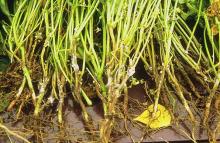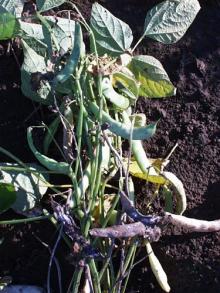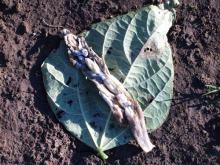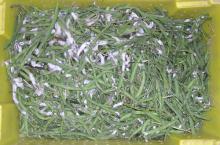By C. M. Ocamb and D. H. Gent
See:
Bean, Snap (Phaseolus vulgaris) - Strategies for Controlling White and Gray Mold in the Same Field
Cause The fungus, Sclerotinia sclerotiorum, causes white mold.
This fungus survives as sclerotia, which may be associated with infected plant residues, contained in seed lots (external or internal to seed), or persist in the soil. Sclerotia can survive three to five years in the soil, depending on environmental conditions and cropping practices. Typically, strains of this fungus outside of tropical zones require a conditioning period in moist soil of several weeks at 40°F or cooler temperatures, after which sclerotia can germinate in soil when the soil water potentials are ≥-100 kPa and temperatures are between 41°F and 68°F. The production of apothecia appears to be prevented when soil matric potentials are below -0.05 MPa. The upper temperature threshold for conditioning and germination of sclerotia is 68°F and 77°F, respectively. Typically, sclerotia germinate and then produce a small, stalked, cup-shaped fruiting structure known as an apothecium, which forcibly ejects millions of ascospores into the air. Sporulating apothecia may persist five to ten days while released ascospores can survive up to two weeks, depending on environmental conditions. Since ascospores require an exogenous nutrient source before infecting a plant, the primary sites for initial infection are senescing tissues such as spent blossoms and declining leaves or plant tissues that have suffered mechanical injuries or wounding through infection by other pathogens. For infection, ascospores require free moisture or a relative humidity close to 100% with a temperature between 50°F and 86°F. Sometimes sclerotia germinate and produce undifferentiated mycelium that directly infects plant portions just below or at the soil line. After infection of the plant has occurred, the mycelium spreads by hyphal growth, the fungus can then invade any healthy, vigorous part of a plant with which it comes in contact, and the pathogen may grow from plant to plant if a diseased plant is in direct physical contact with neighboring plants. Moist conditions within the plant canopy favor infection, as do rain, dew, and/or irrigation practices that keep foliage wet for long periods.
Other susceptible host plants include bean, carrot, pea, lettuce, potato, green pepper, cucurbits, parsnip, radish, sunflower, herbs including mint, fruit trees including apple, nectarine, and sweet cherry, and a large number of ornamentals both woody and herbaceous. Weeds can also be host to S. sclerotiorum; dandelion (Taraxacum officinale) is a very susceptible weed host.
Symptoms The first symptom is usually water-soaked lesions on stem and pods. The fungus may invade the stem near the soil line, causing a rapid wilting and death of the entire plant, or it may invade pods or branches and foliage that comes in contact with colonized tissue. When dry, lesions on infected stems and pods are beige to white due to the production of acetic acid by the fungus. They frequently have sclerotia embedded in them both internally and on external surfaces. In addition, infected stem surfaces may be papery where the epidermis separated from underlying tissue. Newly forming sclerotia are white and change to black after several days.
The beige to white lesion on infected stems and the white mold growth and sclerotia on plant parts help distinguish this disease from Pythium blight, with which white mold may be confused.
Sometimes, the presence of white mold in a field may occur as fine cottony wisps of fungal mycelium growing on plant debris on moist soil. However, many other fungi also can colonize debris, so that is not a useful diagnostic character.
Cultural control
- Reduce humidity and high-moisture periods within the plant canopy and field.
- Provide adequate aeration within, and especially between, rows by increasing plant and row spacing. This is not always economically feasible.
- If available and suitable in quality, plant varieties which are more erect and upright or that do not produce excessive foliage near the ground level (open-base types).
- Orientating the bean rows in the direction of prevailing winds is useful for white mold control if the placement of irrigation equipment allows row orientation.
- Time irrigations to allow drying of plant canopy before night fall.
- Avoid excessive irrigation after petal fall.
- Apply sufficient nitrogen to meet crop demands, but avoid excessive fertilization that can lead to dense, lush plant growth.
- To reduce pathogen population within a field:
- Rotate with non-hosts for three to eight years to achieve best control, but for at least 2 years to reduce population of sclerotia; grasses and cereals are good options since they are thought to not be affected by this fungus.
- Deep plowing buries sclerotia but plowing later years may return viable sclerotia to the surface.
- Field flooding during warm temperatures destroys sclerotia.
- A timely harvest with rapid cooling and pod storage at 45°F to 50°F will provide an effective postharvest control.
Chemical control In fields with a history of white mold, apply fungicide at 1% to 10% bloom (that is, 1 to 10% of the plants in the field have at least one open bloom). A second application may be necessary with highly susceptible varieties or heavy disease pressure.
- Blocker 4F (Group 14) at 4 pints/A at planting and again on 2- to 3-week intervals when disease is severe. Do not apply after the start of pod formation. Do not feed treated vines to livestock. 12-hr reentry.
- Botran 75W (Group 14) at 2 2/3 lb/A on 7-day intervals. Use in the past has shown poor efficacy. Not registered in Oregon. 12-hr reentry.
- Cannonball WP (Group 12) at 7 oz/A when 10% of the plants have at least one (1) open blossom. Preharvest interval is 7 days. 12-hr reentry.
- Carboxamide (Group 7) formulations are registered for use. Do not make more than two (2) sequential applications before alternating to a labeled fungicide with a different mode of action.
- Endura at 8 to 11 oz/A at the beginning of flowering and again at full bloom if conditions are favorable for disease or disease is present. Preharvest interval is 7 days. 12-hr reentry.
- Fontelis at 16 to 30 fl oz/A at the beginning of flowering and again at full bloom if conditions are favorable for disease or disease is present. Preharvest interval is 0 days. 12-hr reentry.
- Luna Privilege at 6.84 fl oz/A on 14-day intervals. Do not make more than two (2) applications before alternating with a fungicide that has a different mode of action. Do not apply within 14 days of harvest. 12-hr reentry.
- Iprodione (Group 2) products such as Rovral 4 Flowable at 1.5 to 2 pints/A when 10% of plants have at least one open bloom and again 5 to 7 days later or up to peak bloom if conditions are favorable for disease. Not recommended in Idaho due to lower level of control. Do not allow foraging for 14 days after last application. 24-hr reentry.
- Jet-Ag at 0.75 to 3.9 fl oz/ 5 gal water as a weekly preventative treatment. A preliminary study showed good control when tank-mixed with Stargus. 4-hr reentry. O
- Omega 500F (Group 29) at 0.5 to 0.85 pint/A when 10% to 30% of the plants have at least one (1) open blossom and if needed again, 7 to 10 days later. Do not apply within 14 days of harvest. 12-hr reentry or 72-hr reentry for high exposure activities.
- Regalia (Group P5) at 1 to 4 quarts/A plus another fungicide on 7- to 10-day intervals. Does not benefit from the addition of an adjuvant. Preharvest interval is 0 days. 4-hr reentry. O
- Switch 62.5WG (Group 12 + 9) at 11 to 14 oz/A. Apply when 10% to 20% of plants have at least one open bloom and again 7 days later. Do not apply within 7 days of harvest. 12-hr reentry.
- Thiophanate-methyl (Group 1) formulations are very effective on Sclerotinia.
- T-Methyl 4.5F AG at 30 to 40 fl oz/A. Make first application when 10% to 30% of plants have at least one open bloom and again no earlier than 7 days later. Preharvest interval is 14 days. 12-hr reentry.
- Topsin 4.5 FL at 30 to 40 fl oz/A for one (1) application or 20 to 30 fl oz/A for two (2) applications. For two (2) applications, make the first application when 10% to 30% of the plants have at least one bloom open and repeat application 4 to 7 days later. For a single application, apply when 100% of the plants have at least one bloom open. Preharvest interval is 14 days. 12-hr reentry.
- Topsin M WSB at 1 to 1.5 lb/A with first application when 10% to 30% of the plants have at least one bloom open and a second application 4 to 7 days later. Do not apply within 14 days of harvest. 24-hr reentry.
Biological control
- Contans WG at 1 to 4 lb/A, depending on depth of incorporation, as a preplant or postharvest treatment. Incorporate thoroughly in the top 2 inches of soil. 4-hr reentry. O
- Double Nickel LC at 1 to 6 quarts/A at planting and again at cultivation, can repeat on 10- to 14-day intervals. Can be applied the day of harvest. 4-hr reentry. O
- Serenade Opti at 14 to 20 oz/A on 7- to 10-day intervals. Applications can be made up to and the day of harvest. 4-hr reentry. O
- Stargus at 2 to 4 quarts/A plus a nonionic surfactant on 7- to 10-day intervals. Gave good control when used in a 2-spray program in studies conducted by Cornell. Preharvest interval is 0 days. 4-hr reentry. O
References Caesar, A.J., and Pearson, R.C. 1983. Environmental factors affecting survival of ascospores of Sclerotinia sclerotiorum. Phytopathology 73(7):1024-1030.
Hao, J.J., Subbarao, K.V., and Duniway, J.M. 2003. Germination of Sclerotinia minor and S. sclerotiorum sclerotia under various soil moisture and temperature combinations. Phytopathology 93:443-450.
Mila, A.L., and Yang, X.B. 2008. Effects of fluctuating soil temperature and water potential on sclerotia germination and apothecial production of Sclerotinia sclerotiorum. Plant Dis. 92:78-82.
Pethybridge, S.J., Bowden, C., Murphy, S., and Kikkert, J.R. 2019. Efficacy of fungicides for control of white mold in snap bean, 2018. Plant Disease Management Reports 13:V021.





